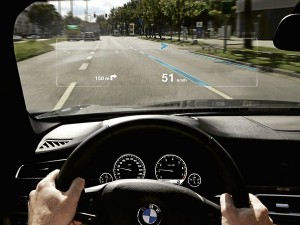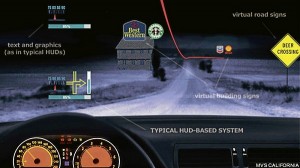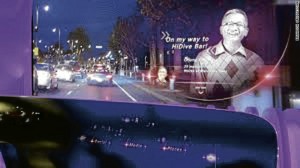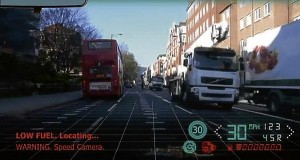
Overlaying real world images with digital ones, the augmented reality windshield can display driving directions, text messages or impending hazards, all without requiring the driver to take his eyes off the road. Augmented reality has been in the iPhone since 2008, but it can radically change the way we drive and interact with technology. INTERNET SOURCES
If you’re dazzled by all the high-tech innovations found in new cars today—such as Bluetooth, Blind Spot obstacle detection, Active City Safety, Active Cruise Control radar, Collision Warning with full auto brake and pedestrian detection, Attention Assist to detect drowsy driving and Active Park Assis—get ready to be dazzled some more.
As the automotive industry marches inexorably toward the car of the future, a.k.a. the self-driving car, tech companies are coming up with cutting-edge systems in-vehicle and out that would make driving safer, more pleasant and more efficient.
One such system is the augmented reality windshield that, by overlaying real world images with digital ones, can display driving directions, text messages or impending hazards, all without requiring the driver to take his eyes off the road. Augmented reality has been in the iPhone since 2008, but it can radically change the way we drive and interact with technology.

INTEGRATED. In Contact Analogue Display Technology, the displayed info is integrated into the external environment in the correct perspective and at the actual point or points in the scene to which it relates, so that the info effectively appears to be “attached” to the external objects. Since the info is presented in the driver’s direct line of sight and is overlaid on the objects it is referring to, the driver doesn’t have to shift his attention away from the driving scene, his gaze is not distracted and he doesn’t have to change focus as he does when looking back to the road from the instrument cluster or central info display. So info relevant to the driving situation can be scanned more quickly and more directly and at the same time currently required actions can be displayed in intuitive form.
On the other hand, according to an article by Greg Bensinger in the Wall Street Journal (WSJ), carmakers like Daimler and General Motors are working on windshields with simple graphics that allow drivers to see digital renditions of their surroundings such as difficult-to-see road edges, pedestrians and/or animals as well as draw attention to erratic drivers.
The technology works via cameras in the vehicle that track the driver’s eye and head to determine where he is looking, and sensors outside the car track pointing at moving and stationary objects. Bensinger quotes the GM chief technologist for human machine interface as cautioning that augmented reality has to be done very judiciously lest the windshield be cluttered with too much information and become a distraction.
HAND MOTIONS. The WSJ article reports that Daimler envisions an augmented reality windshield that can respond to hand motions to display information, such as factoids about a city’s landmarks, weather and traffic updates. Moreover, by showing social media posts without requiring the driver to look away from the road as reading a smartphone would, the augmented reality windshield makes texting and driving safer.
The CEO of Daimler’s Mercedes-Benz Research and Development North America claims that if the whole car, including the windshield, can be linked to drivers’ smartphones, drivers could upload their calendars to the windshield, and view and respond to text messages. He noted that people are becoming more reliant on their smartphones to navigate through the day, so a future is possible where so much of their world can be brought to them while they are driving.
However, both Daimler and GM said it would take at least five years before augmented reality windshields can be installed in vehicles and made available to the public.
BIOMETRIC SENSORS. Meanwhile, WSJ “Eyes on the Road” columnist James B. White wrote last month that major auto manufacturers are developing a technology that can save drivers from having an accident by sensing drivers’ illness or rising stress levels and activating the car’s safety systems such as tapping the brakes, turning off a radio, blocking a cell phone from ringing. So-called biometric sensors, writes White, would keep tabs on vital signs including pulse, breathing, sweat, heart rate, brain waves and even blood sugar level (the latter via a smartphone app), feed the info into computers that manage a car’s safety system and thus enable the vehicle to better react to whatever challenges the road and traffic dish out.
White mentions the already existing in-cabin cameras of some Lexus models like the GS and steering sensors in some Mercedes-Benz vehicles like the S-Class that detect drowsy driving behavior, sound a warning beep or flash an icon to suggest a break. Sports car maker Ferrari SpA is evaluating technology that would embed wireless electrodes in a car seat’s headrest to monitor brain waves for stress and, depending on what the sensors detect, the car would try to reduce risk by cutting power or by automatically stabilizing the vehicle.
But while phone-disabling technology may come to Ford Motor Co. showrooms “fairly quickly,” according to a senior technical leader involved with Ford’s research project connecting info from medical monitors to its cars’ in-dash multimedia systems, biometric sensors are “further out” due to medical privacy and regulatory issues.
Whether they are brought to the market soon or many years later, accident-preventing technologies like the augmented reality windshield and biometric sensors deserve to be welcomed by consumers.
Sources: The WSJ, motoringfile.com

